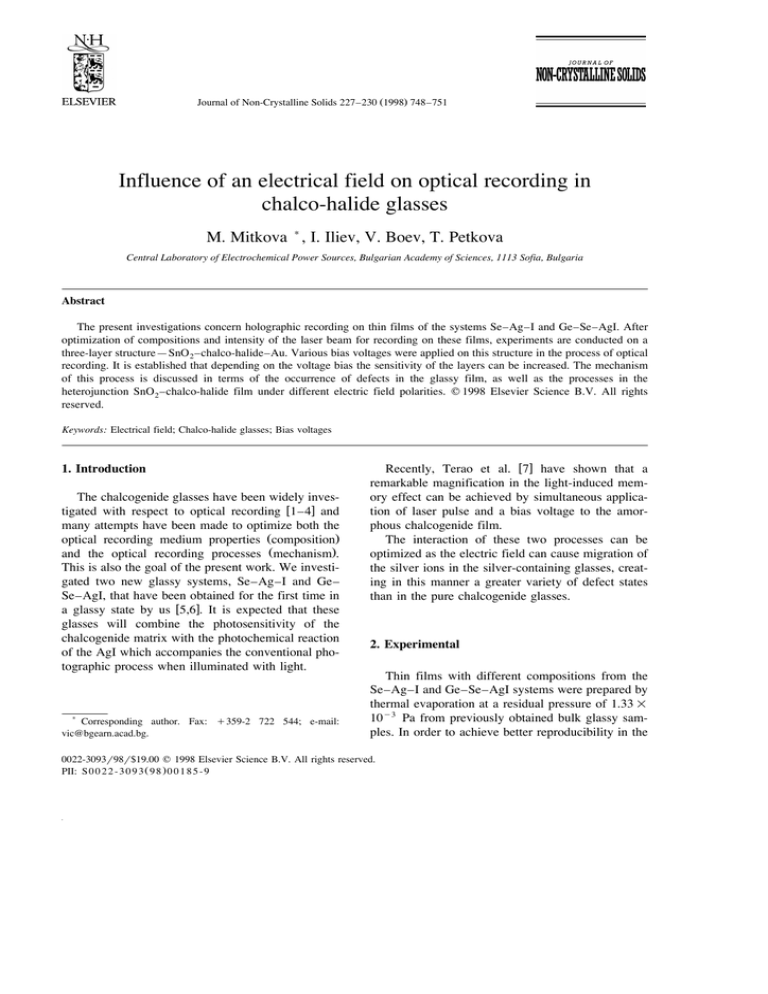
Journal of Non-Crystalline Solids 227–230 Ž1998. 748–751
Influence of an electrical field on optical recording in
chalco-halide glasses
M. Mitkova ) , I. Iliev, V. Boev, T. Petkova
Central Laboratory of Electrochemical Power Sources, Bulgarian Academy of Sciences, 1113 Sofia, Bulgaria
Abstract
The present investigations concern holographic recording on thin films of the systems Se–Ag–I and Ge–Se–AgI. After
optimization of compositions and intensity of the laser beam for recording on these films, experiments are conducted on a
three-layer structure—SnO 2 –chalco-halide–Au. Various bias voltages were applied on this structure in the process of optical
recording. It is established that depending on the voltage bias the sensitivity of the layers can be increased. The mechanism
of this process is discussed in terms of the occurrence of defects in the glassy film, as well as the processes in the
heterojunction SnO 2 –chalco-halide film under different electric field polarities. q 1998 Elsevier Science B.V. All rights
reserved.
Keywords: Electrical field; Chalco-halide glasses; Bias voltages
1. Introduction
The chalcogenide glasses have been widely investigated with respect to optical recording w1–4x and
many attempts have been made to optimize both the
optical recording medium properties Žcomposition.
and the optical recording processes Žmechanism..
This is also the goal of the present work. We investigated two new glassy systems, Se–Ag–I and Ge–
Se–AgI, that have been obtained for the first time in
a glassy state by us w5,6x. It is expected that these
glasses will combine the photosensitivity of the
chalcogenide matrix with the photochemical reaction
of the AgI which accompanies the conventional photographic process when illuminated with light.
)
Corresponding author. Fax: q359-2 722 544; e-mail:
vic@bgearn.acad.bg.
Recently, Terao et al. w7x have shown that a
remarkable magnification in the light-induced memory effect can be achieved by simultaneous application of laser pulse and a bias voltage to the amorphous chalcogenide film.
The interaction of these two processes can be
optimized as the electric field can cause migration of
the silver ions in the silver-containing glasses, creating in this manner a greater variety of defect states
than in the pure chalcogenide glasses.
2. Experimental
Thin films with different compositions from the
Se–Ag–I and Ge–Se–AgI systems were prepared by
thermal evaporation at a residual pressure of 1.33 =
10y3 Pa from previously obtained bulk glassy samples. In order to achieve better reproducibility in the
0022-3093r98r$19.00 q 1998 Elsevier Science B.V. All rights reserved.
PII: S 0 0 2 2 - 3 0 9 3 Ž 9 8 . 0 0 1 8 5 - 9
M. MitkoÕa et al.r Journal of Non-Crystalline Solids 227–230 (1998) 748–751
Fig. 1. Schematic view of sample structure.
properties of the films and to prevent spattering of
unmelted fragments, a special thermal evaporator
with an additional grill was constructed and used. It
creates evaporating conditions near to those of a
Knudsen cell w8x.
The films 0.8 to 1.5 mm thick were deposited
onto a glass substrate previously coated with a SnO 2
conductive layer. This deposition was followed by
another deposition of an Au layer about 0.1 mm
thick, creating in this manner Au electrodes with an
area of 10 = 8 mm2 . A schematic view of the specimens is shown in Fig. 1.
The irradiation was directed on the side of the
SnO 2 film by a holographic set up to create diffraction gratings in the chalco-halide films. The experimental set-up for holographic recording is shown in
Fig. 2. A standard interferometric configuration with
a continuous Arq laser with a wavelength l s 488
nm produces fringes with a spatial frequency of 200
mmy1 . The intensity of the interfering beams is
controlled by a gradual attenuator. The recording
beam intensity is varied in the range of 0.2 to 4.0
Wrcm2 .
During the irradiation time, an electric field was
created on the gold and SnO 2-electrodes. In this
manner holographic recording was accomplished on
the chalco-halide films at various electric voltages in
Fig. 2. Experimental set-up for holographic investigation. L1: Arq
laser, PR: polarization rotator, A: gradual attenuator, W: Wollaston prism, M: mirror, L 2 : He–Ne laser, l r2: phase plate, S:
sample, D: photosensor, mA: milliamperemeter, V: voltmeter, PS:
power source.
749
the range of 2 to 6 V and alternating polarity. The
sample, whose Au electrode is connected positively
andror negatively, is named as forward andror
reverse direction.
Thus the influence of the electric field polarity
was also investigated. The effects obtained by this
holographic recording were evaluated by measuring
the diffraction efficiency of the obtained gratings.
3. Results
More than 10 specimens with different compositions from both systems were studied. To optimize
the optical recording conditions, the temporal dependencies of the diffraction efficiency at various laser
beam intensities were investigated. We established
that a maximal value of the diffraction efficiency is
exhibited for samples with compositions Se 70 Ag 15 I 15
and ŽGeSe 4 . 90 ŽAgI.10 at intensities 3.3 and 0.5
Wrcm2 , respectively. These results are illustrated in
Fig. 3a and b. It is evident that at a larger laser beam
Fig. 3. Diffraction efficiency vs. exposure time. Ža. For the
composition Se 70 Ag 15 I 15 at laser beam intensities: Ž1. I s 2.2
Wrcm2 , Ž2. I s 3.3 Wrcm2 , Ž3. I s 4.4 Wrcm2 . Žb. For the
composition ŽGeSe 4 . 90 ŽAgI.10 at laser beam intensities: Ž1. I s 0.2
Wrcm2 , Ž2. I s 0.5 Wrcm2 , Ž3. I s1.1 Wrcm2 , Ž4. I s 2.2
Wrcm2 .
750
M. MitkoÕa et al.r Journal of Non-Crystalline Solids 227–230 (1998) 748–751
intensity, the diffraction efficiency increases reaching maxima in less time.
The investigations of the effects of the electric
field on the optical recording were carried out at
optimal recording conditions and compositions for
both systems. The results of the measurements are
plotted in Fig. 4a for the films with composition
Se 70 Ag 15 I 15 and Fig. 4b for the composition
ŽGeSe 4 . 90 ŽAgI.10 . The magnitudes of the applied
electric voltages were limited by the destruction of
the chalco-halide films. The diffraction efficiency
decreased when the optical recording is made through
the gold electrode due to the semitransparency of the
Au film. The investigations indicate differences in
the behaviour of the recording properties depending
on the polarity of the gold electrodes. When the gold
electrode is biased negatively, the diffraction efficiency decreases in all cases. When the gold electrode is biased positively, we show that there is a
difference in the shape of the curves of the temporal
Fig. 4. Diffraction efficiency vs. exposure time with applying
voltages. Ža. For the composition Se 70 Ag 15 I 15 at laser beam
intensity 3.3 Wrcm2 : Ž1. without any voltage, Ž2. at 2 V, Ž3. at 3
V, Ž4. at 4 V, Ž5. at y2 V. Žb. For the composition
ŽGeSe 4 . 90 ŽAgI.10 at laser beam intensity 0.5 Wrcm2 : Ž1. at 6 V,
Ž2. at 2 V, Ž3. without any voltage, Ž4. at y2 V.
behaviour of the diffraction efficiency for the two
investigated compositions. For the composition
Se 70 Ag 15 I 15 , the increase in the electric voltage
leads to an increased sensitivity of the film, but the
diffraction efficiency is less. For the composition
ŽGeSe 4 . 90 AgI 10 , the diffraction efficiency is about 2
times greater than that obtained without application
of an electric voltage. On the other hand, the sensitivity of the film is practically constant.
4. Discussion
Discussing the effects obtained, we should take
into account two main points: the band structure of
the investigated system and the formation of defects
in the glassy phases under the particular conditions.
The band gap for the SnO 2 electrode, which is
known to be n-type degenerate semiconductor, is 3.5
eV, whereas the chalcogenide glasses possess smaller
band gaps being p-type semiconductors. For example, for the system Se–Ag–I, the band gap varies
from 1.6 to 1.9 eV depending on the composition w9x.
On the other hand, the interface between Au and the
chalcogenide film forms an ohmic contact. Even if
we assume that the initial condition of the films is
close to the equilibrium one and the number of
defects is so small that film properties are not affected, after light illumination their number will
increase due to the reaction with silver and iodine
ions obtained by the photoreaction of AgI. So, if we
adopt the model of Kastner et al. w10x for the defects
in the chalcogenide glasses, which includes a large
variety of possible combinations of charge states and
coordination number, the following reactions will
occur:
q
C 20 q Ag 0 ™ Cy
1 q Ag ,
Ž 1.
y
2C 20 q I 02 ™ 2Cq
3 q 2I .
Ž 2.
When the sample is illuminated with a laser beam
under an applied forward bias voltage, electrons and
holes generated in the chalco- halide films by the
mechanism described will move toward the Au and
SnO 2 electrodes. In the forward direction, the drift
velocity of the carriers must be larger since they
should be accelerated by the electric field in the
M. MitkoÕa et al.r Journal of Non-Crystalline Solids 227–230 (1998) 748–751
chalco-halide thin films. In the reverse direction, the
depletion layer should be formed near the heterojunction Se–SnO 2 . In our films the width of the
depletion layer becomes comparable with the film
thicknesses w11x. Therefore, the electric field effect
increases the effects of the light irradiation because
the electric field affects the light-induced migration
of the defects. The observed magnification in the
light-induced memory effect under the forward bias
voltage is thus assumed to originate from the photocurrent produced by the electric field in the film.
So, the reaction of the films of both systems gives
grounds to suppose that glasses from the system
Ge–Se–AgI are better photoconductors since the
effects are longer than in the other composition. The
different results obtained for both systems are probably connected with the different band structure of the
investigated chalco-halide films. For the Se–Ag–I
system, the band gap is smaller than in the other case
w9x, having also many defect levels in the gap caused
by the presence of the elements with high ionicity
seeks as silver and iodine. In the system Ge–Se–AgI,
the band gap is much wider and the effects of the
silver and iodine ions is diminished by the three-dimensionality of the structure.
5. Conclusion
The obtained results show that depending on the
electric field polarity, application of electric field
751
during the imaging process may lead to a higher
sensitivity of the active chalco-halide material for
recording optical gratings with higher diffraction efficiency.
Acknowledgements
This work has been supported by the National
Science Foundation of Bulgaria, Grant No. X 558.
References
w1x K. Shimakawa, A. Kolobov, S.R. Elliott, Adv. Phys. 44
Ž1995. 475.
w2x K. Schwartz, J. Inf. Rec. 22 Ž1996. 289.
w3x J.N. Jamada, MRS Bull. 21 Ž9. Ž1996. 48.
w4x K. Tanaka, Curr. Opin. Solid State Mater. Sci. 1 Ž1996. 567.
w5x M. Mitkova, T. Petkova, A. Janakiev, Matter Chem. Phys. 30
Ž1991. 55.
w6x V. Boev, M. Mitkova, L. Nikolova, T. Todorov, P. Sharlandjiev, M. Vlcek, Opt. Mater., to be published.
w7x M. Terao, H. Yamamoto, E. Maruyama, Proceedings of the
4th Conference of Solid State Devices, Jpn. Soc. Appl. Phys.,
Tokyo, 1972, p. 233.
w8x T. Petkova, M. Mitkova, Thin Solid Films 205 Ž1991. 25.
w9x T. Petkova, M. Mitkova, Radiat. Eff. Defects Solids 137
Ž1995. 183.
w10x M. Kastner, D. Adler, H. Fritzsche, Phys. Rev. Lett. 37
Ž1976. 1504.
w11x M. Okuda, T. Matsushita, T. Yamagami, K. Yamamoto,
Appl. Opt. 13 Ž1974. 799.







